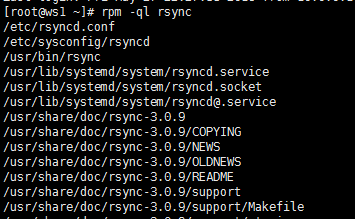rsync+inotify实现数据同步
Posted
tags:
篇首语:本文由小常识网(cha138.com)小编为大家整理,主要介绍了rsync+inotify实现数据同步相关的知识,希望对你有一定的参考价值。
Rsync原理:
Rsync是基于rsync算法校验源(SRC)与目标(DEST)之间的差异实现数据同步的。也就是说,当使用rsync工具同步数据的时候,只复制源发生改变的文件,到目标(DEST),这类似于增量备份。所以rsync同步数据的速度是很快的。但是rsync的传输性能很差,在海量小文件需要同步时,表现很不好。因为rsync是基于文件同步的(不是块级别的),在传输之前还要进行校验。
Rsync的工作模式有多种,使用rsync的服务模式来构建:主/从服务器的数据同步。此时rsync工作为守护进程监听在:TCP/873,能收到客户端的数据同步请求。
inotify原理:
inotify可以监控文件,也可以监控目录。当监控目录时,它可以同时监控目录及目录中的各子目录及文件的变化。由于intify使用文件扫描符作为借口,因此可以使用通常的文件I/O操作例如select、pool、epoll来见识文件系统的变化
环境需求:
Host1:
CentOS-7-x86_64
hostname:ws1
ipaddr:10.0.0.61
Host2:
CentOS-6-x86_64
hostname:ws2
ipaddr:10.0.0.62
注意:两台主机均为最小化安装iptables和selinux均处于关闭状态
配置Host1
CentOS 7最小化安装,默认已安装rsync包
编辑rsync的配置文件
# vim /etc/rsyncd.conf uid = root //rsync同步共享用户的身份 gid = root //rsync同步共享用户组的身份 use chroot = no //不使用chroot port = 873 //定义监听的端口,默认873 max connections = 200 //服务器最大并发数 timeout = 300 //会话超时时长 pid file = /var/run/rsyncd.pid //pid文件存放路径 lock file = /var/run/rsyncd.lock //lock文件存放路径,服务启动停止时会用到 log file = /var/log/rsyncd.log //日志文件存放路径 log format = %h %o %1 %b //日志记录格式 ignore errors //忽略错误信息 read only = false //是否允许用户上传文件,默认为true list = false //是否允许用户列出文件,默认为true write only = false //是否允许下载,默认为true hosts allow = 10.0.0.61/8 //允许哪些主机访问 hosts deny = * s //拒绝哪些主机访问 auth users = sync //同步时认证所需的用户 secrets file = /etc/rsyncd.passwd //认证时所需的密码文件 [data] //模块名称,客户端需精确指定模块名称 path = /data //模块对应的目录路径
创建认证时的密码文件/etc/rsyncd.passwd(需要用户名和密码、明文存储,仅属主可读)
# echo "sync:123456" > /etc/rsynd.passwd # chmod 600 /etc/rsynd.passwd
创建模块对应的目录,并确保属主和属组与配置文件中定义的uid和gid一致
# mkdir -p /data/ # ls -ld /data/ drwxr-xr-x 2 root root 21 5月 27 22:47 /data/ # cp /var/log/message /data/
启动服务,并检查进程和监听端口
# systemctl start rsyncd.service # ps aux | grep rsync root 3121 0.0 0.1 114640 1164 ? Ss 22:47 0:00 /usr/bin/rsync --daemon --no-detach root 3123 0.0 0.0 112660 956 pts/0 R+ 22:48 0:00 grep --color rsync # ss -tunl | grep 873 tcp LISTEN 0 5 *:873 *:* tcp LISTEN 0 5 :::873 :::*
配置host2
创建认证时的密码文件~/rsyncd。passwd(仅需密码,明文存储、仅属主可读)
# echo "123456" > rsyncd.passwd # chmod 600 rsyncd.passwd
测试查看rsync服务器上data模块中的文件
]# rsync --password-file=rsyncd.passwd [email protected]::data drwxr-xr-x 21 2016/05/27 22:47:34 . -rw------- 242668 2016/05/27 22:47:35 messages
注意:再一次踩坑,一定一定一定检查防火墙
建立本地数据目录文件/data,将/data目录与rsync服务器上data模块中定义的目录/data作为数据同步目录,即这两个目录中的数据要时刻保持一致。
测试:将host1的/data目录中的数据取过来。
# rsync -avz --password-file=rsyncd.passwd [email protected]::data /data/ receiving incremental file list ./ messages sent 76 bytes received 26839 bytes 53830.00 bytes/sec total size is 242668 speedup is 9.02
然后在本地创建几个文件使用rsync命令同步到Host1的data目录中
# rsync -avz --password-file=rsyncd.passwd /data/ [email protected]::data sending incremental file list ./ rsyncd.passwd sent 2567 bytes received 34 bytes 5202.00 bytes/sec total size is 30649078 speedup is 11783.57
注意:目录后面的/ 如果少加了一个/,会将data目录本身而不是目录下的文件同步过去
# rm -f /data/fstab # rsync -avz --delete --password-file=rsyncd.passwd /data/ [email protected]::data sending incremental file list deleting fstab sent 2521 bytes received 12 bytes 5066.00 bytes/sec total size is 30649078 speedup is 12099.91
此时手动同步两个节点上目录中数据文件是没有问题了,现在需要实现的是Host2上的数据一改变立刻同步Host1上的数据,这就需要用到inotify了
inptify
inotify是内核中功能,但是需要通过系统调用接口程序才能够使用,这个接口程序由inotify-tools提供,所以嘛咱得安装!!!此处我们在host2上安装
# yum install -y inotify-tools # # rpm -ql inotify-tools /usr/bin/inotifywait /usr/bin/inotifywatch /usr/lib64/libinotifytools.so.0 /usr/lib64/libinotifytools.so.0.4.1
以下是几个inotify相关的内核参数,可能根据实际需要调整
# ls -l /proc/sys/fs/inotify/ 总用量 0 -rw-r--r-- 1 root root 0 5月 28 00:23 max_queued_events -rw-r--r-- 1 root root 0 5月 28 00:23 max_user_instances -rw-r--r-- 1 root root 0 5月 28 00:23 max_user_watches
实时监控数据目录文件,发生改变立刻调用rsync进行数据同步,脚本如下
# vim auto_rsync.sh #!/bin/bash sync_user="sync" sync_host="10.0.0.61" sync_mod="data" data_dir="/data/" rsync_cmd="rsync -vzrtopg --delete --progress --password-file=./rsyncd.passwd $data_dir [email protected]$sync_host::$sync_mod" inotifywait -mrq $data_dir --timefmt ‘%d/%m/%y %H:%M‘ --format ‘%T %w%f%e‘ -e modify,delete,create,attrib | while read files; do $rsync_cmd done
启动脚本,然后修改Host2 数据目录中的文件,观察变化
bash auto_rsync.sh sending incremental file list ./ deleting issue deleting .auto_rsync.sh.swp auto_rsync.sh 359 100% 0.00kB/s 0:00:00 (xfer#1, to-check=108/110) sent 2800 bytes received 34 bytes 5668.00 bytes/sec total size is 30649390 speedup is 10814.89
以上是关于rsync+inotify实现数据同步的主要内容,如果未能解决你的问题,请参考以下文章
